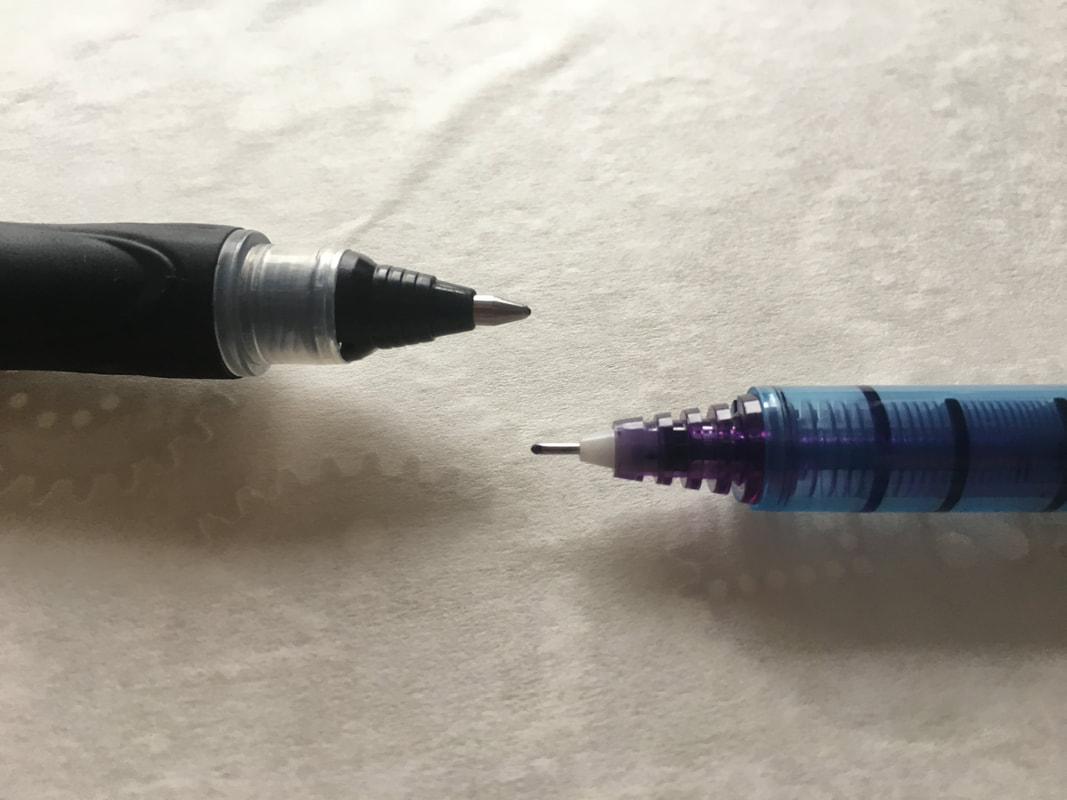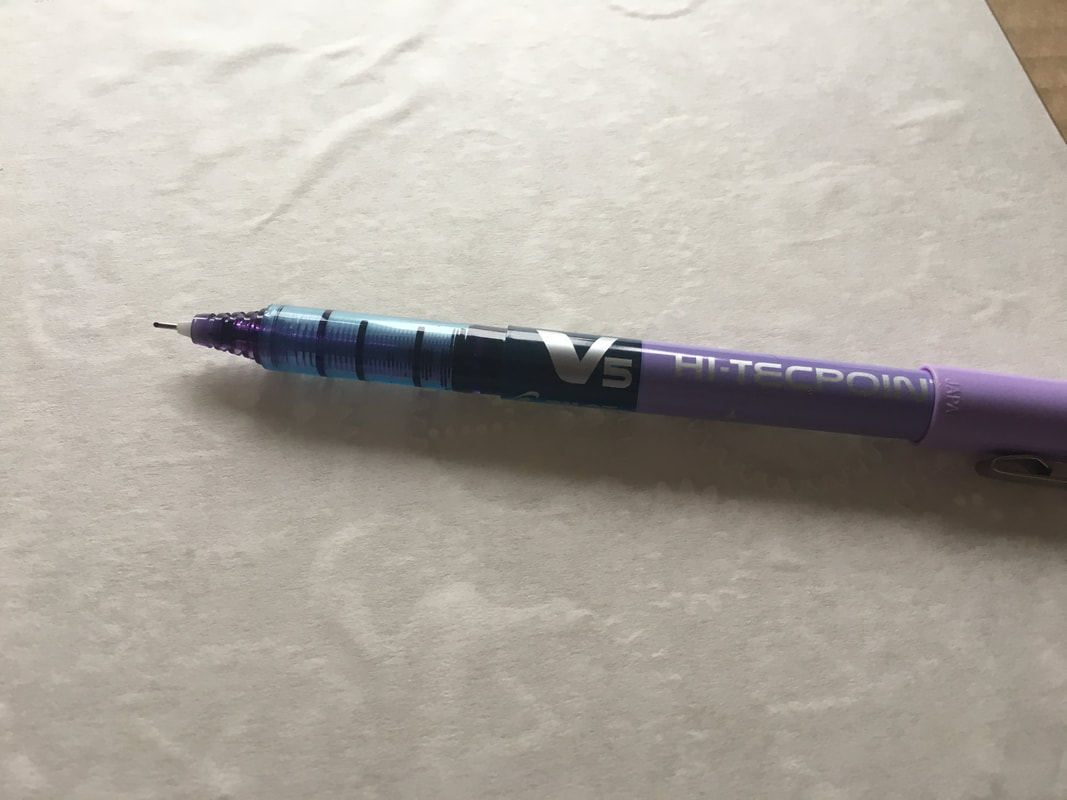Pens:
In terms of pen recommendations I will make the following general suggestions. Experiment with whatever pens you have on hand. Avoid gel pens, they are globby and smudgy, until you want to play with that messy effect on purpose. Felt tipped pens have stronger, more consistent, line quality but will bleed into the paper if held stationary whereas ballpoint pens bleed less (or not at all) but can have inconsistent line quality if they are used fast as sometimes they cannot supply ink to the ball fast enough to maintain high line quality.
I enjoy the Hi-Techpoint lining pens and the Staedtler Stabilo as well as Bic Rollerball pens. Sharpies are good too. That being said I think that experimentation is good to do. I regularly buy inexpensive pen sets just to see how they will work and explore the range of styles different pens offer. I've formed more opinions about blue and black ink properties than I thought it was possible to hold.
Paper:
I'd suggest getting some printer paper. I like using heavy stock printer paper; it has more solidity for when designs cross in the same place a bunch of times. Heavy stock refers to the lb weight listed on the package. The heavier the better; but regular printer paper is great to use too. This relatively cheap paper allows me to experiment lots without feeling like I am wasting expensive paper. Nicer art papers are also great to use and I have a selection of sizes and colours to deploy as needed. Paper can also be bought by the roll if you want to just cover your table and go to town. This is also a good way to work on larger designs without having to dedicate a page of a large form art book to experimentation.
On bound sketch books. If you are considering a book with a spiral binding, or any other sort that doesn't open completely flat keep the gear frame in mind. The designs might fit on the paper but the frame or hoop that the designs are going to be contained in could easily overlap the edges of the paper. Ones I make often overlap all the sides by several inches at least. This means that if the book you are using has a raised metal binding the frame cannot sit flat on the paper which means that the gears won't work properly or at all. Pads of paper with a glue binding on one side could prove to be flexible enough to lay flat but if the glue binding strip is reinforced with fabric or other fibers that might still get in the way. There is a huge variety of paper out there; have fun experimenting.
Pens for the tiny holes:
Pens with a cylindrical metal barrel fit into the smallest (~1mm) holes. Art lining pens will often be constructed this way. Some pens from office supply stores (or random stationary sections) will have this feature too.
In terms of pen recommendations I will make the following general suggestions. Experiment with whatever pens you have on hand. Avoid gel pens, they are globby and smudgy, until you want to play with that messy effect on purpose. Felt tipped pens have stronger, more consistent, line quality but will bleed into the paper if held stationary whereas ballpoint pens bleed less (or not at all) but can have inconsistent line quality if they are used fast as sometimes they cannot supply ink to the ball fast enough to maintain high line quality.
I enjoy the Hi-Techpoint lining pens and the Staedtler Stabilo as well as Bic Rollerball pens. Sharpies are good too. That being said I think that experimentation is good to do. I regularly buy inexpensive pen sets just to see how they will work and explore the range of styles different pens offer. I've formed more opinions about blue and black ink properties than I thought it was possible to hold.
Paper:
I'd suggest getting some printer paper. I like using heavy stock printer paper; it has more solidity for when designs cross in the same place a bunch of times. Heavy stock refers to the lb weight listed on the package. The heavier the better; but regular printer paper is great to use too. This relatively cheap paper allows me to experiment lots without feeling like I am wasting expensive paper. Nicer art papers are also great to use and I have a selection of sizes and colours to deploy as needed. Paper can also be bought by the roll if you want to just cover your table and go to town. This is also a good way to work on larger designs without having to dedicate a page of a large form art book to experimentation.
On bound sketch books. If you are considering a book with a spiral binding, or any other sort that doesn't open completely flat keep the gear frame in mind. The designs might fit on the paper but the frame or hoop that the designs are going to be contained in could easily overlap the edges of the paper. Ones I make often overlap all the sides by several inches at least. This means that if the book you are using has a raised metal binding the frame cannot sit flat on the paper which means that the gears won't work properly or at all. Pads of paper with a glue binding on one side could prove to be flexible enough to lay flat but if the glue binding strip is reinforced with fabric or other fibers that might still get in the way. There is a huge variety of paper out there; have fun experimenting.
Pens for the tiny holes:
Pens with a cylindrical metal barrel fit into the smallest (~1mm) holes. Art lining pens will often be constructed this way. Some pens from office supply stores (or random stationary sections) will have this feature too.
Other Tools and tricks:
Holding the pieces still can be challenging for longer designs. There are many ways to make this easier.
Some people like to use:
- putty to stick the hoops or gears do the paper. Elmer's Poster Tack comes highly recommended by some.
- heavy objects like weights, or books, or cans of food. These are easy to find around the house and very versatile.
- magnets and a metal sheet. Many small strong magnets placed around the hoop to hold it and the paper still is a very secure method. Be careful when using magnets as they can pinch you or break if allowed to snap together.
- a clipboard. Some pieces fit nicely on a clipboard and can be held steady that way. Additional binder or bulldog clips can further secure additional edges.

